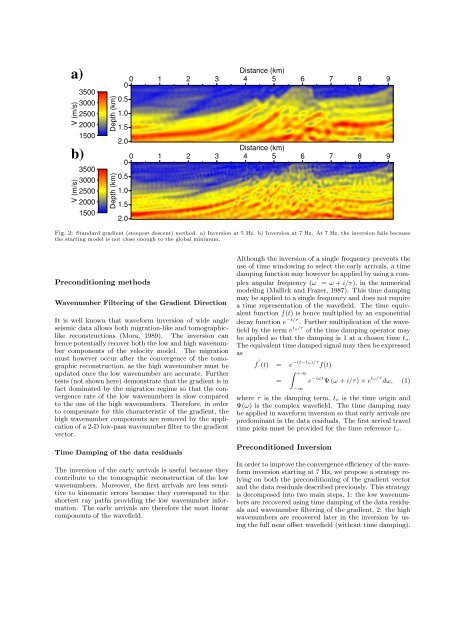Sirgue, L., and Pratt, R. G., 2003. - Queen's University
Sirgue, L., and Pratt, R. G., 2003. - Queen's University
Sirgue, L., and Pratt, R. G., 2003. - Queen's University
Create successful ePaper yourself
Turn your PDF publications into a flip-book with our unique Google optimized e-Paper software.
a)<br />
V (m/s)<br />
3500<br />
3000<br />
2500<br />
2000<br />
1500<br />
b)<br />
V (m/s)<br />
3500<br />
3000<br />
2500<br />
2000<br />
1500<br />
Depth (km)<br />
Depth (km)<br />
Distance (km)<br />
0 1 2 3 4 5 6 7 8 9<br />
0<br />
0.5<br />
1.0<br />
1.5<br />
2.0<br />
0<br />
0.5<br />
1.0<br />
1.5<br />
2.0<br />
Distance (km)<br />
0 1 2 3 4 5 6 7 8 9<br />
Fig. 2: St<strong>and</strong>ard gradient (steepest descent) method. a) Inversion at 5 Hz. b) Inversion at 7 Hz. At 7 Hz, the inversion fails because<br />
the starting model is not close enough to the global minimum.<br />
Preconditioning methods<br />
Wavenumber Filtering of the Gradient Direction<br />
It is well known that waveform inversion of wide angle<br />
seismic data allows both migration-like <strong>and</strong> tomographiclike<br />
reconstructions (Mora, 1989). The inversion can<br />
hence potentially recover both the low <strong>and</strong> high wavenumber<br />
components of the velocity model. The migration<br />
must however occur after the convergence of the tomographic<br />
reconstruction, as the high wavenumber must be<br />
updated once the low wavenumber are accurate. Further<br />
tests (not shown here) demonstrate that the gradient is in<br />
fact dominated by the migration regime so that the convergence<br />
rate of the low wavenumbers is slow compared<br />
to the one of the high wavenumbers. Therefore, in order<br />
to compensate for this characteristic of the gradient, the<br />
high wavenumber components are removed by the application<br />
of a 2-D low-pass wavenumber filter to the gradient<br />
vector.<br />
Time Damping of the data residuals<br />
The inversion of the early arrivals is useful because they<br />
contribute to the tomographic reconstruction of the low<br />
wavenumbers. Moreover, the first arrivals are less sensitive<br />
to kinematic errors because they correspond to the<br />
shortest ray paths providing the low wavenumber information.<br />
The early arrivals are therefore the most linear<br />
components of the wavefield.<br />
Although the inversion of a single frequency prevents the<br />
use of time windowing to select the early arrivals, a time<br />
damping function may however be applied by using a complex<br />
angular frequency (ω ′<br />
= ω + i/τ), in the numerical<br />
modeling (Mallick <strong>and</strong> Frazer, 1987). This time damping<br />
may be applied to a single frequency <strong>and</strong> does not require<br />
a time representation of the wavefield. The time equivalent<br />
function f(t) is hence multiplied by an exponential<br />
decay function e −t/τ . Further multiplication of the wavefield<br />
by the term e to/τ of the time damping operator may<br />
be applied so that the damping is 1 at a chosen time t o.<br />
The equivalent time damped signal may then be expressed<br />
as<br />
f ′ (t) = e −(t−to)/τ f(t)<br />
=<br />
∫ +∞<br />
−∞<br />
e −iωt Ψ (ω + i/τ) × e to/τ dω, (1)<br />
where τ is the damping term, t o is the time origin <strong>and</strong><br />
Ψ(ω) is the complex wavefield. The time damping may<br />
be applied in waveform inversion so that early arrivals are<br />
predominant in the data residuals. The first arrival travel<br />
time picks must be provided for the time reference t o.<br />
Preconditioned Inversion<br />
In order to improve the convergence efficiency of the waveform<br />
inversion starting at 7 Hz, we propose a strategy relying<br />
on both the preconditioning of the gradient vector<br />
<strong>and</strong> the data residuals described previously. This strategy<br />
is decomposed into two main steps, 1: the low wavenumbers<br />
are recovered using time damping of the data residuals<br />
<strong>and</strong> wavenumber filtering of the gradient, 2: the high<br />
wavenumbers are recovered later in the inversion by using<br />
the full near offset wavefield (without time damping).

















